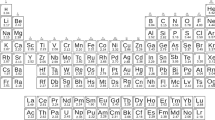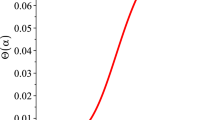Abstract
EUCKEN and his collaborators have pointed out that the failure of Nernst's heat theorem—the so-called third law of thermodynamics—which occurs in some cases, is due to the zero-point entropy1. A definite zero-point entropy arises from the existence of ‘frozen-in’ phases stable at higher temperatures which do not reach the real thermal equilibrium on cooling to the neighbourhood of the absolute zero. Teske and I, for example, have found that solid carbon monoxide near 10°K. exhibits such a state in spite of its crystalline structure2. Clay ton and Giauque have confirmed this result3 and explained the discrepancy by the suggestion that the asymmetry of the carbon monoxide molecule gives rise to two positions in the lattice of nearly equal energy. The formation of a fully ordered crystal is thus prevented. No such effect is to be expected in the case of nitrogen, which is a symmetrical molecule. Dr. Teller has directed my attention to the fact that similar behaviour may be shown by nitrous oxide as opposed to the symmetrical carbon dioxide: this has proved to be true.
This is a preview of subscription content, access via your institution
Access options
Subscribe to this journal
Receive 51 print issues and online access
$199.00 per year
only $3.90 per issue
Buy this article
- Purchase on Springer Link
- Instant access to full article PDF
Prices may be subject to local taxes which are calculated during checkout
Similar content being viewed by others
References
Eucken and Fried, Z. Phys., 29, 36; 1924. Eucken . Phys. Z., 30, 818; 1929. 31, 361; 1930.
Clusius and Teske, Z. phys. Chem. (B), 6, 135; 1929.
Clayton and Giauque, J. Amer. Chem. Soc., 54, 2610; 1932.
Clusius, Hiller and Vaughen, Z. phys. Chem., (B), 8, 427; 1930,
Johnston and Giauque, J. Amer. Chem. Soc., 51, 3194; 1929.
Plyler and Barker, Phys. Rev., 38, 1825; 1931. Martin and Barker, Phys. Rev., 41, 291; 1932.
Author information
Authors and Affiliations
Rights and permissions
About this article
Cite this article
CLUSIUS, K. Origin of Zero-Point Entropy. Nature 130, 775–776 (1932). https://doi.org/10.1038/130775b0
Issue Date:
DOI: https://doi.org/10.1038/130775b0
This article is cited by
-
Thermodynamics and the Structure of Matter*
Nature (1940)
Comments
By submitting a comment you agree to abide by our Terms and Community Guidelines. If you find something abusive or that does not comply with our terms or guidelines please flag it as inappropriate.



